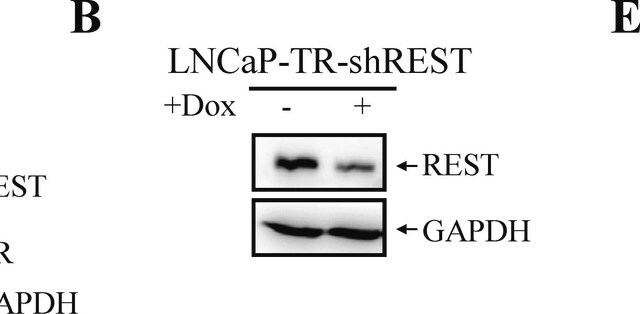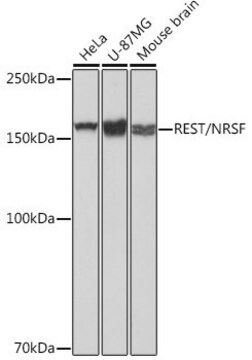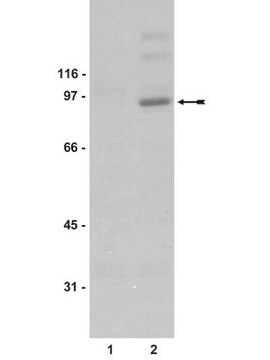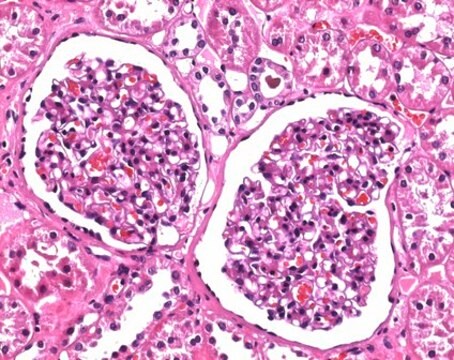07-579
Anti-REST Antibody
Upstate®, from rabbit
Sinônimo(s):
Neural-restrictive silencer factor, RE1-silencing transcription factor, X2 box repressor, neuron restrictive silencer factor, repressor binding to the X2 box
About This Item
Produtos recomendados
fonte biológica
rabbit
Nível de qualidade
forma do anticorpo
purified immunoglobulin
tipo de produto de anticorpo
primary antibodies
clone
polyclonal
reatividade de espécies
human
fabricante/nome comercial
Upstate®
técnica(s)
western blot: suitable
Isotipo
IgG
nº de adesão NCBI
nº de adesão UniProt
Condições de expedição
wet ice
modificação pós-traducional do alvo
unmodified
Informações sobre genes
human ... REST(5978)
mouse ... Rest(19712)
rat ... Rest(83618)
Descrição geral
Especificidade
Imunogênio
Aplicação
Epigenetics & Nuclear Function
Transcription Factors
From the summary:
"Finally, the glycosylation pattern of the REST protein was analysed, moving from the observation that the molecular weight calculated on REST sequence is about 116 kDa but using western blotting this transcription factor appears to have distinct apparent molecular weight (see Table 1.1): this difference could be explained by post-translational modifications of the proteins, like glycosylation. In fact recently, several studies underlined the importance of O-glycosylation in modulating transcriptional silencing, protein phosphorylation, protein degradation by proteasome and protein–protein interactions [Julenius et al., 2005; Zachara and Hart, 2006]. Deglycosilating analysis showed that REST protein in SH-SY5Y and HEK293 cells is Oglycosylated and not N-glycosylated. Moreover, using several combination of deglycosilating enzymes it is possible to hypothesize the presence of Gal-β(1-3)-GalNAc residues on the endogenous REST, while β(1-4)-linked galactose residues may be present on recombinant REST protein expressed in HEK293 cells. However, the O-glycosylation process produces an immense multiplicity of chemical structures and monosaccharides must be sequentially hydrolyzed by a series of exoglycosidase. Further experiments are needed to characterize all the post-translational modification of the transcription factor REST." In particular the authors show that REST migrates at 200kd in SH-SY5Y cells.
Qualidade
Descrição-alvo
forma física
Armazenamento e estabilidade
Nota de análise
Positive Antigen Control: Catalog #12-309, Hela cell nuclear extract. Add an equal volume of Laemmli reducing sample buffer to 10 μL of extract and boil for 5 minutes to reduce the preparation. Load 20 μg of reduced extract per lane for minigels.
Outras notas
Informações legais
Exoneração de responsabilidade
Não está encontrando o produto certo?
Experimente o nosso Ferramenta de seleção de produtos.
recomendado
Código de classe de armazenamento
12 - Non Combustible Liquids
Classe de risco de água (WGK)
WGK 2
Ponto de fulgor (°F)
Not applicable
Ponto de fulgor (°C)
Not applicable
Certificados de análise (COA)
Busque Certificados de análise (COA) digitando o Número do Lote do produto. Os números de lote e remessa podem ser encontrados no rótulo de um produto após a palavra “Lot” ou “Batch”.
Já possui este produto?
Encontre a documentação dos produtos que você adquiriu recentemente na biblioteca de documentos.
Nossa equipe de cientistas tem experiência em todas as áreas de pesquisa, incluindo Life Sciences, ciência de materiais, síntese química, cromatografia, química analítica e muitas outras.
Entre em contato com a assistência técnica








